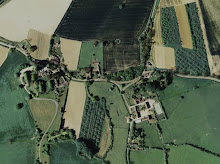
Using the internet to document my orchard obsessions has allowed me to discover fruity wonderlands in far away lands. Recently, I was contacted by Helmut and Monika who manage such a place on the southern shore of Lake Constance in Switzerland between Romanshom and Arbon. They've generously donated some photos of their farm, and I think you will agree with me that it looks like quite a place!

It's a rare example of a commercial fruit farm of the most traditional form, with 550 trees of apple, pear, plum and cherry set over 10.5 hectares. The trees are standards, planted on vigorous rootstocks and allowed to grow to full height. These are the type of orchards that are so rich in biodiversity and are a 'priority' habitat for conservation in the UK. It has been a family run enterprise for 120 years, but the age of some of the trees demonstrates a tradition of fruit growing that stretches back much further.

This photo shows one of their fantastic old perry pear trees, a type of fruit tree that is particularly beautiful after a hundred years of growth. Sadly trees like this are becoming increasingly rare in the UK.

This tree is an apple variety called 'Gravenstein' that Heklmut and Monika make a single variety sweet cider from. You can see the poles they use to prop up the heavily laden branches preventing breakages in the Autumn - a technique I haven't yet seen employed in Britain. Tender loving care!

This is another apple called 'Muolener Rosen'. Apparently is a variety that is largely unknown but produces a very healthy vigorous tree that crops productively in alternate years. Many cider varieties show this cropping pattern in Britain, especially in unpruned traditional orchards.

Harvest time in the orchards. The farm is totally organic, with the main income coming from sales of fresh fruit and sweet cider in the farm shop. They also supply apples and pears to a local cider factory. They also supply to retail outlets in Bern and Basel.

They produce other single variety ciders, such as 'Sauergrauech', 'Leuenapfel' and 'Taffetapfel'. (Just when you thought you were making headway in the labarinthine world of fruit varieties, hey!).

A pleasing traditional orchard scene with the next generation of trees beautifully complementing the more venerable characters! If only more orchards in Britain had such a continuity of horticulture and habitat.

Autumn colours remeniscent of James Stanley's orchard near Ebrington in Gloucestershire.


I'm not sure what the winters are like in this part of Switzerland, but presumably they are pretty hardcore. Ideal for killing off pathogens in the trees and preventing disease outbreaks.


This amazing tree is a another perry pear. A fruit-growing research station near Zurich came down and aged this tree at 300 years old! The variety is called 'Wagner's Wildbirne' that is good for fermenting and drying too. Apparently its found nowhere else in Switzerland. You get trees approaching this age in Britain but I have never seen one with such wide spreading branches. She's a BEAUTY!

They have also developed their own variety called the 'Emmy' apple which is exclusively available from this farm. Thats the young tree in the foreground here. Helmut and Monika explained that they included this photo to illustrate that with vigorous 'seedling' rootstocks (e.g. M25) it is a fallicy that it takes years and years for trees to start producing.
All in all, I feel an orchard holiday in the making!



Oh, very cool. Brilliant photos of those lovely old perry pear trees. I'm trying to convince my OH to see the potential in planting vigorious rare and heritage fruit varities in a parkland setting (they look nice, they're more intersting/novel than your average beech and in parkland, theres room to grow). I'm mentioned some of these big trees grown on the contient but not had such nice photos to back me up until now! Great post!
ReplyDeletewe hope to get some more visitors from england interested in the big trees.
ReplyDeletethe orchard is open to public by agreement. We meanwhile continue to plant even more extra rare apple varieties from all over europe as well as some unique seedlings.....